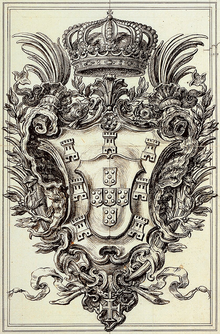
Back Portugiesische Heraldik German Heráldica portuguesa Spanish Heráldica portuguesa Portuguese Португальська геральдика Ukrainian
 Coat of arms of King João V of Portugal, as designed by João Frederico Ludovice; 1744. | |
| Heraldic tradition | Latin |
|---|---|
| Governing body | Several |
Portuguese heraldry encompasses the modern and historic traditions of heraldry in Portugal and the Portuguese Empire. Portuguese heraldry is part of the larger Iberian tradition of heraldry, one of the major schools of heraldic tradition, and grants coats of arms to individuals (usually members of the Portuguese Royal Family or the Portuguese nobility), cities, Portuguese colonies, and other institutions. Heraldry has been practiced in Portugal at least since the 12th century, however it only became standardized and popularized in the 16th century, during the reign of King Manuel I of Portugal, who created the first heraldic ordinances in the country. Like in other Iberian heraldic traditions, the use of quartering and augmentations of honor is highly representative of Portuguese heraldry, but unlike in any other Iberian traditions, the use of heraldic crests is highly popular.
© MMXXIII Rich X Search. We shall prevail. All rights reserved. Rich X Search